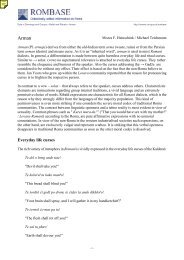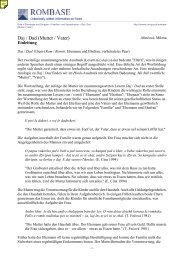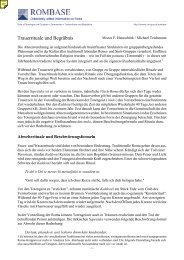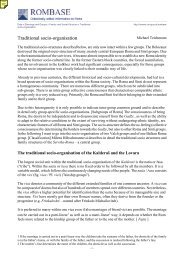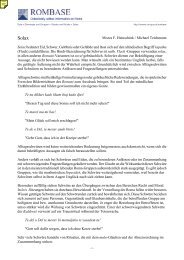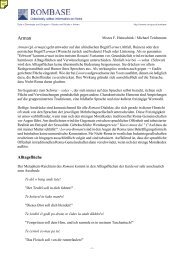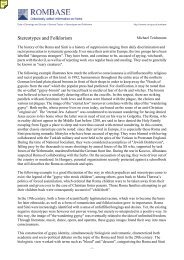Maria Theresia and Joseph II
Maria Theresia and Joseph II
Maria Theresia and Joseph II
Create successful ePaper yourself
Turn your PDF publications into a flip-book with our unique Google optimized e-Paper software.
Data » History <strong>and</strong> Politics » Modern Times (to 1945) » <strong>Maria</strong> <strong>Theresia</strong> <strong>and</strong><br />
<strong>Joseph</strong> <strong>II</strong><br />
<strong>Maria</strong> <strong>Theresia</strong> <strong>and</strong> <strong>Joseph</strong> <strong>II</strong><br />
Policies of Assimilation in the Age of Enlightened Absolutism<br />
Helmut Samer<br />
The Age of Enlightened Absolutism was characterised by essential changes in the sovereign policies<br />
toward the "gypsies". In the face of the complete failure of all attempts to banish them permanently<br />
from their dominion, the sovereigns of the Enlightenment were searching for new methods <strong>and</strong> ways<br />
to solve the "gypsy problem" from the second half of the 18th century on. Therefore, assimilation by<br />
decree of the state was added to the methods of expulsion <strong>and</strong> persecution of the Roma that have been<br />
practiced to this day.<br />
Measures forcing the Roma to give up their ways of life were taken, to do away with an "uncontrollable<br />
nuisance" <strong>and</strong> to transform so called "unproductive" parts of the population into "respectable, obedient<br />
<strong>and</strong> diligent people". It was their most important goal to keep the Roma from w<strong>and</strong>ering about <strong>and</strong> to<br />
make the hitherto "roving <strong>and</strong> vagabond gypsies" settle down permanently. The coercion to live rural<br />
lives or to learn civic trades, <strong>and</strong> the destruction of their cultural identity, was supposed to lead to an<br />
assimilation into society.<br />
The primary motives behind the enforcement of assimilation at that time undoubtedly were the aspiration<br />
of the centralised state to control its subjects, <strong>and</strong> integrated Roma into the existing economic system.<br />
But the religious beliefs of a few sovereigns also played a role. They saw an honorable duty in the<br />
"civilisation" of the "gypsies", quasi Christian response to enforce their "re-education" into becoming<br />
"good Christians".<br />
The policies of assimilation during that time were based on the way the Enlightenment viewed human<br />
beings: the individual was regarded as "capable of learning <strong>and</strong> improving". At the same time, the<br />
measures that were taken to assimilate the Roma rested upon the assumption that their culture was<br />
inferior on principle. The physical extermination of the "gypsies" was replaced by the destruction of<br />
their culture <strong>and</strong> traditional ways of life. Only in comparison to the brutal persecution of former eras<br />
could this new way of dealing with the Roma be possibly seem as progressive. Moreover, the methods<br />
applied in "civilising" the Roma - such as taking away their children - were in many cases more brutal<br />
<strong>and</strong> inhumane.<br />
Very early attempts by the state to assimilate the Roma can be found in Spain. As early as in 1619 the<br />
authorities wanted to force the w<strong>and</strong>ering Roma to sedentarise, <strong>and</strong> used methods of assimilation such<br />
as forbidding the use of Romani (1633), separating parents <strong>and</strong> children <strong>and</strong> committing the children<br />
to orphanages, <strong>and</strong> sending men <strong>and</strong> women to separate workhouses (1686, 1725).<br />
<strong>Maria</strong> <strong>Theresia</strong>, the Empress of the Austro-Hungarian Empire, set an example with her policies of<br />
assimilation that influenced many other sovereigns. Striving to make the Roma settle down as "new<br />
citizens" or "new farmers", she issued altogether four great decrees during her reign (1740-1780). By<br />
means of these decrees the Roma would be forced to give up their ways of life.<br />
The first decree (1758) forced the "gypsies" to sedentarise. They were denied the right to own horses<br />
<strong>and</strong> wagons in order to keep them from "nomadising". Furthermore, the Roma were issued l<strong>and</strong> <strong>and</strong><br />
seeds <strong>and</strong> became liable to pay tribute from their crops just like the other subjects of the crown. They<br />
were supposed to build houses <strong>and</strong> had to ask for permission <strong>and</strong> state an exact purpose if they wanted<br />
to leave their villages.<br />
- 1 -<br />
http://romani.uni-graz.at/rombase
Data » History <strong>and</strong> Politics » Modern Times (to 1945) » <strong>Maria</strong> <strong>Theresia</strong> <strong>and</strong><br />
<strong>Joseph</strong> <strong>II</strong><br />
In the next decree (1761) the term "Zigani", which was commonly used for the Roma at that time,<br />
was replaced by the terms "new citizen" (Hungarian: "Ujpolgár"), "new farmer" (Hungarian:<br />
"Ujparasztok"), "new Hungarian" (Hungarian: "Ujmagyar") or "new settler" (Hungarian: "Ujlakosok"<br />
or Latin: "Neocolonus"). They were supposed to give up their old ways of life, together with their old<br />
name, in order to accelerate the process of integration. "Gypsy boys" would learn a trade or be recruited<br />
for military service at the age of sixteen if they were fit for service.<br />
In 1767 <strong>Maria</strong> <strong>Theresia</strong> had the jurisdiction withdrawn from the Voivods <strong>and</strong> all "gypsies" became<br />
subject to the local jurisdiction (3rd decree). At the same time, they were ordered to register <strong>and</strong> -<br />
based on this registration - conscriptions were carried out for the first time.<br />
The fourth decree issued in 1773 prohibited marriages between Roma. Mixed marriages were<br />
encouraged by subsidies. The permission to get married, however, was bound to an attestation of "a<br />
proper way of life <strong>and</strong> knowledge of the Catholic religious doctrine". Since the Empress <strong>and</strong> her<br />
counselors were of the opinion that the "civilization" of the "gypsies"was the basis for a successful<br />
"domiciliation", she ordered that all children over the age of five should be taken away from their<br />
parents <strong>and</strong> be h<strong>and</strong>ed over to a Hungarian farmer’s family who were supposed to take charge of their<br />
Christian upbringing against payment. The children should grow up isolated from their own parents<br />
in different comitats, go to school <strong>and</strong> later learn a trade or become farmers.<br />
Although <strong>Maria</strong> <strong>Theresia</strong>’s successor, Josef <strong>II</strong> (1780-1790), released the Roma of Buchowina that had<br />
been living in bondage, he continued the policies of assimilation started by his mother. Issued in 1783,<br />
the guide lines ""de Domiciliatione et Regulatione Zingarorum" enforced assimilation even more<br />
rigorously. Not only were more restrictions - such as the compulsory adoption of the clothing <strong>and</strong> the<br />
language of the village people - imposed on the Roma, but they were also threatened with harsh<br />
punishment for offences against these restrictions.<br />
For the use of the "gypsy language", for example, the law provided a flogging with 24 blows. Despite<br />
the sanctions ordered in case of offences, the coercive measures imposed by <strong>Maria</strong> <strong>Theresia</strong> <strong>and</strong> <strong>Joseph</strong><br />
<strong>II</strong> were effective only to a certain degree. They only succeeded permanently in what is Burgenl<strong>and</strong><br />
today, where the Roma actually settled down <strong>and</strong> have stayed up to the present. A large number of<br />
Roma were successfully assimilated there: frequently children did not return to their own parents,<br />
stayed on the farms of their foster parents or learned a trade <strong>and</strong> married into a non-Roma-family. [<br />
Stereotypes <strong>and</strong> Folklorism] In a few towns the Roma assimilated completely into the village population.<br />
The process of assimilation is mirrored in the disappearance of the formerly multifarious family names<br />
in the conscriptions of the "gypsies".<br />
In other territories of the monarchy, however, the Roma offered resistance against the way of life<br />
ordered by the state, they evaded the harsh compulsory measures <strong>and</strong> took to the road again. The state<br />
at this time lacked the necessary human resources to translate the regulations into action or to return<br />
the Roma that had escaped. Moreover, as they were generally completed according to the expectations<br />
of the authorities, the lists of conscription often did not show any need for action.<br />
The liberal Spanish King Karl <strong>II</strong>I (Carlos Tercero) tried to "civilize" the "gitanos" in the same year as<br />
<strong>Joseph</strong> <strong>II</strong> (1783). In the 44 articles of his "pragmatica" he prohibited their w<strong>and</strong>ering, the use of their<br />
language ("el caló"), their typical clothing, <strong>and</strong> the horse trade as well as other itinerant trades. The<br />
King wanted the "gitanos" to settle down at a place of their choice <strong>and</strong> to practice "proper" trades.<br />
These measures were bound to fail because they were also rejected by the rest of the population -<br />
- 2 -<br />
http://romani.uni-graz.at/rombase
Data » History <strong>and</strong> Politics » Modern Times (to 1945) » <strong>Maria</strong> <strong>Theresia</strong> <strong>and</strong><br />
<strong>Joseph</strong> <strong>II</strong><br />
towns <strong>and</strong> their citizens refused to take the Roma in <strong>and</strong> employ them. The "gitanos" continued<br />
practicing their itinerant trades but under even more difficult <strong>and</strong> impoverished circumstances.<br />
In Germany similar measures, though on a smaller scale, were taken. A few sovereigns tried to make<br />
the "gypsies" settle down on their territories, such as the Count of Wittgenstein, who had the "gypsy<br />
settlement" Saßmannshausen erected in 1771. Friedrich <strong>II</strong> of Prussia, a contemporay <strong>and</strong> rival of <strong>Maria</strong><br />
<strong>Theresia</strong>, founded the "gypsy settlement" Friedrichslohra in a remote area near Nordhausen in 1775<br />
in order to make Sinti groups who had been "roaming the l<strong>and</strong> as beggars <strong>and</strong> thiefs" settle down<br />
permanently. The attempt to transform the Sinti into the States idea of "clean, proper, obedient <strong>and</strong><br />
diligent" people failed miserably. After 1830 the adults were committed to workhouses <strong>and</strong> the<br />
Martinsstift in Erfurt (a convent) took charge of the children.<br />
- 3 -<br />
http://romani.uni-graz.at/rombase
Data » History <strong>and</strong> Politics » Modern Times (to 1945) » <strong>Maria</strong> <strong>Theresia</strong> <strong>and</strong><br />
<strong>Joseph</strong> <strong>II</strong><br />
References<br />
Fonseca, Isabell (1996) Begrabt mich aufrecht. Auf den Spuren der Zigeuner, München.<br />
Fraser, Angus (1992) The Gypsies. Oxford.<br />
Heinschink, Mozes F. / Hemetek, Ursula (eds.) (1994) Roma. Das unbekannte Volk. Schicksal<br />
und Kultur, Wien.<br />
Mayerhofer, Claudia (1999) Dorfzigeuner. Kultur und Geschichte der Burgenl<strong>and</strong>-Roma von<br />
der Ersten Republik bis zur Gegenwart, Wien.<br />
Remmel, Franz (1993) Die Roma Rumäniens. Wien.<br />
Vossen, Rüdiger (1983) Zigeuner. Roma, Sinti, Gitanos, Gypsies zwischen Verfolgung und<br />
Romantisierung, Hamburg.<br />
- 4 -<br />
http://romani.uni-graz.at/rombase





